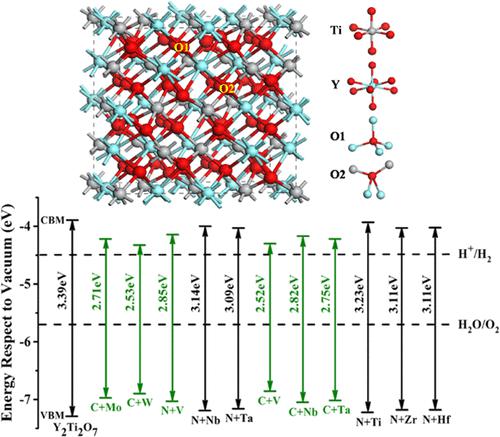当前位置:
X-MOL 学术
›
J. Phys. Chem. C
›
论文详情
Our official English website, www.x-mol.net, welcomes your
feedback! (Note: you will need to create a separate account there.)
Tailoring Structural, Electronic, Optical, and Photocatalytic Properties of Y2Ti2O7 through a Passivated Codoping Approach
The Journal of Physical Chemistry C ( IF 3.3 ) Pub Date : 2024-01-24 , DOI: 10.1021/acs.jpcc.3c07623
Xinyue Yang 1 , Hongrui Li 1 , Hao Dong 1 , Xin Zhou 2
The Journal of Physical Chemistry C ( IF 3.3 ) Pub Date : 2024-01-24 , DOI: 10.1021/acs.jpcc.3c07623
Xinyue Yang 1 , Hongrui Li 1 , Hao Dong 1 , Xin Zhou 2
Affiliation

|
The large band gap of the Y2Ti2O7 photocatalyst has limited its application only in the ultraviolet region. To enhance its photocatalytic activity for overall water splitting in the visible-light region, we have utilized a passivated codoping approach to construct eleven (X + M)-doped Y2Ti2O7 systems (X = C, N, M = Ti, V, Zr, Nb, Mo, Hf, Ta, W), where a Ti/Y site is replaced with a metal dopant. The calculated negative formation energies indicate that all of the (X + M)-doped systems are easy to synthesize, especially under the O-rich condition. The implantation of dopants can change the crystal structure to different extents. The less the deformation of the crystal, the easier the formation of the (X + M)-doped Y2Ti2O7. The passivated codoping can effectively narrow the band gap without generating isolated defect states in the forbidden gap. (X + M)-doped Y2Ti2O7 retains the direct band gap characteristics and possesses the separation rate of photogenerated carriers similar to or even higher than that of the pure crystal. Compared to (N + M)-doped systems, (C + M)-doped systems exhibit more remarkable influence on narrowing the band gap and extending the absorption edge mainly because the C dopant has deeper acceptor energy levels and a stronger interaction with the metal dopant than the N dopant. The capabilities of photooxidation and photoreduction of water have been enhanced by adopting the codoping strategy. By considering the binding energy, band gap, optical absorption, and the relative position of band edges, we propose that (C + Mo)-, (C + W)-, (N + V)-, (C + V)-, (C + Nb)- and (C + Ta)-doped Y2Ti2O7 are potential visible-light-responsive photocatalysts for overall water splitting.
中文翻译:

通过钝化共掺杂方法定制 Y2Ti2O7 的结构、电子、光学和光催化性能
Y 2 Ti 2 O 7光催化剂的大带隙限制了其仅在紫外区的应用。为了增强其在可见光区域整体水分解的光催化活性,我们利用钝化共掺杂方法构建了11个(X + M)掺杂的Y 2 Ti 2 O 7系统(X = C,N,M = Ti 、V、Zr、Nb、Mo、Hf、Ta、W),其中 Ti/Y 位点被金属掺杂剂取代。计算出的负形成能表明所有 (X + M) 掺杂体系都很容易合成,特别是在富 O 条件下。掺杂剂的注入可以不同程度地改变晶体结构。晶体变形越小,越容易形成(X+M)掺杂的Y 2 Ti 2 O 7。钝化共掺杂可以有效地缩小带隙,而不会在禁带中产生孤立的缺陷态。 (X+M)掺杂的Y 2 Ti 2 O 7保留了直接带隙特性,并且具有与纯晶体相似甚至更高的光生载流子分离率。与(N+M)掺杂体系相比,(C+M)掺杂体系对缩小带隙和延长吸收边表现出更显着的影响,这主要是因为C掺杂剂具有更深的受主能级以及与金属更强的相互作用掺杂剂比N掺杂剂。采用共掺杂策略增强了水的光氧化和光还原能力。通过考虑结合能、带隙、光学吸收和能带边缘的相对位置,我们提出(C + Mo)-、(C + W)-、(N + V)-、(C + V)- 、(C + Nb)-和(C + Ta)-掺杂的Y 2 Ti 2 O 7是用于整体水分解的潜在可见光响应光催化剂。
更新日期:2024-01-24
中文翻译:

通过钝化共掺杂方法定制 Y2Ti2O7 的结构、电子、光学和光催化性能
Y 2 Ti 2 O 7光催化剂的大带隙限制了其仅在紫外区的应用。为了增强其在可见光区域整体水分解的光催化活性,我们利用钝化共掺杂方法构建了11个(X + M)掺杂的Y 2 Ti 2 O 7系统(X = C,N,M = Ti 、V、Zr、Nb、Mo、Hf、Ta、W),其中 Ti/Y 位点被金属掺杂剂取代。计算出的负形成能表明所有 (X + M) 掺杂体系都很容易合成,特别是在富 O 条件下。掺杂剂的注入可以不同程度地改变晶体结构。晶体变形越小,越容易形成(X+M)掺杂的Y 2 Ti 2 O 7。钝化共掺杂可以有效地缩小带隙,而不会在禁带中产生孤立的缺陷态。 (X+M)掺杂的Y 2 Ti 2 O 7保留了直接带隙特性,并且具有与纯晶体相似甚至更高的光生载流子分离率。与(N+M)掺杂体系相比,(C+M)掺杂体系对缩小带隙和延长吸收边表现出更显着的影响,这主要是因为C掺杂剂具有更深的受主能级以及与金属更强的相互作用掺杂剂比N掺杂剂。采用共掺杂策略增强了水的光氧化和光还原能力。通过考虑结合能、带隙、光学吸收和能带边缘的相对位置,我们提出(C + Mo)-、(C + W)-、(N + V)-、(C + V)- 、(C + Nb)-和(C + Ta)-掺杂的Y 2 Ti 2 O 7是用于整体水分解的潜在可见光响应光催化剂。

































 京公网安备 11010802027423号
京公网安备 11010802027423号